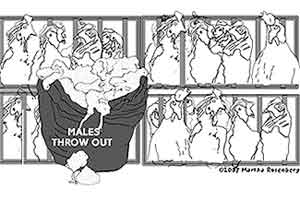|
Special Reports On a hot, windy day in May, Liz and Garrett Perry of Waterloo, Wisconsin, were disposing of scrap lumber at the Deer Track Park landfill near Interstate 94 when a featherless, debeaked hen limped in front of their pickup truck. Oh that, said landfill workers. Live hens often come out of the construction bins Creekwood Farm brings here with spent laying hens they've gassed. In June, unwary canoers on Raccoon Creek near Sac City,
Iowa, paddled upon 31 dead pigs. Authorities found 100 more close by -- dumped
by a local farrowing operation when they died en route to the finishing
facility. Factory farming isn't just a nightmare -- it's a nightmare for PR professionals trying to defend it! Just ask Aaron Putze, executive director of Coalition to
Support Iowa�s Farmers (CSIF), a group formed to "grow new and existing
livestock enterprises and navigate regulations and siting." A native Iowan who says he remembers when manure management was ''sloped concrete and a 3-inch rain," Putze contends, "Fifty hogs and a couple dairy cows isn't going to send kids to college today.'' But other Iowa natives regard CSIF's activities -- it helped Andy Muff of Ventura upsize the family farm to a 4,000 "contract finishing operation" and Wendell Davison of Garner grow from 150 to 11,000 pigs -- as not neighborly. "I have no problem smelling manure from our 90 head cow/calf operation or our 450 hogs. 5,000 in one yard is a different story," posts a farmer from southwest Iowa on the Des Moines Register web site. "It is a common occurrence that one of their employees will drive down the road with a full load of manure and accidentally open the back hatch dumping manure on the road for quite some distance. Or we'll see a dead steer laying in a field for a week or two eventually rotting into the earth." "I wouldn't call a 6,000 cow dairy funded by investor
money with many low-wage employees a family farm," writes a self-described
young Iowan farmer on his blog. CSIF will "save family farmers by converting them into
Hog House janitors," writes another Des Moines Register poster, cutting to
the chase. In fact, four busloads of anti-factory farm Iowans, many of them farmers, converged on Putze's west Des Moines house in July, planting a "bad neighbor" award on his lawn. Nor have Karl Rove or Tony Snow expressed interest in CSIF
positions. Similar sentiment greeted representatives from the National Pork Board and Monsanto in Vernon County, Wisconsin, in July, when farmers rolled more than 50 tractors and farm implements to a county board meeting to support an ordinance banning new large-scale livestock operations. And Ohio Fresh Eggs, when it resumed operations
in Croton after being shut down by the Department of Agriculture, to the
dismay of neighbor Richard Woodgeard says his grandchildren need to carry
flyswatters in the house when they visit him. Nor has spin doctoring worked in Arizona where Hormel
subsidiary Pigs for Farmer John is trying to build a 52,800-pig facility in
Yuma County. Thousands of pigs can be raised without pollution, said
Michael Terrill, Pigs for Farmer John vice president, while giving a tour of
the company's pig facility in Snowflake, which generates flies and odor for
miles, according to the Arizona Republic. But when farmers, neighboring landowners and environmentalists heard the facility would use 7.8 billion gallons of water and produce 28 million gallons of manure to be spread (or is that "fertilize"?) on 2,500 acres of virgin desert they said you're building what? Construction has been temporarily halted. There is also the issue of animal care. Confinement of thousands of animals in small spaces isn't
cruel, says Terrill, who is a veterinarian, because, "If we're not taking
care of that animal, they're not going to take care of us." But his good-care-through-self-interest argument falters
when considering the 20,000 Smithfield hogs that drowned in their pens during
Hurricane Floyd and egg farms like Creekwood that routinely destroy spent hens. And farmers like Jan and Nancy Pannekoek of Chilliwack, BC, and Lynn Peters of Flora, Indiana. who let their hogs perish not once but TWICE in recent hog barn fires -- Peters losing over 3,300. "We'll get through this," he told the local paper,
no doubt planning to raise more hogs. Copyright © 1998-2007 Online Journal Email Online Journal Editor |
